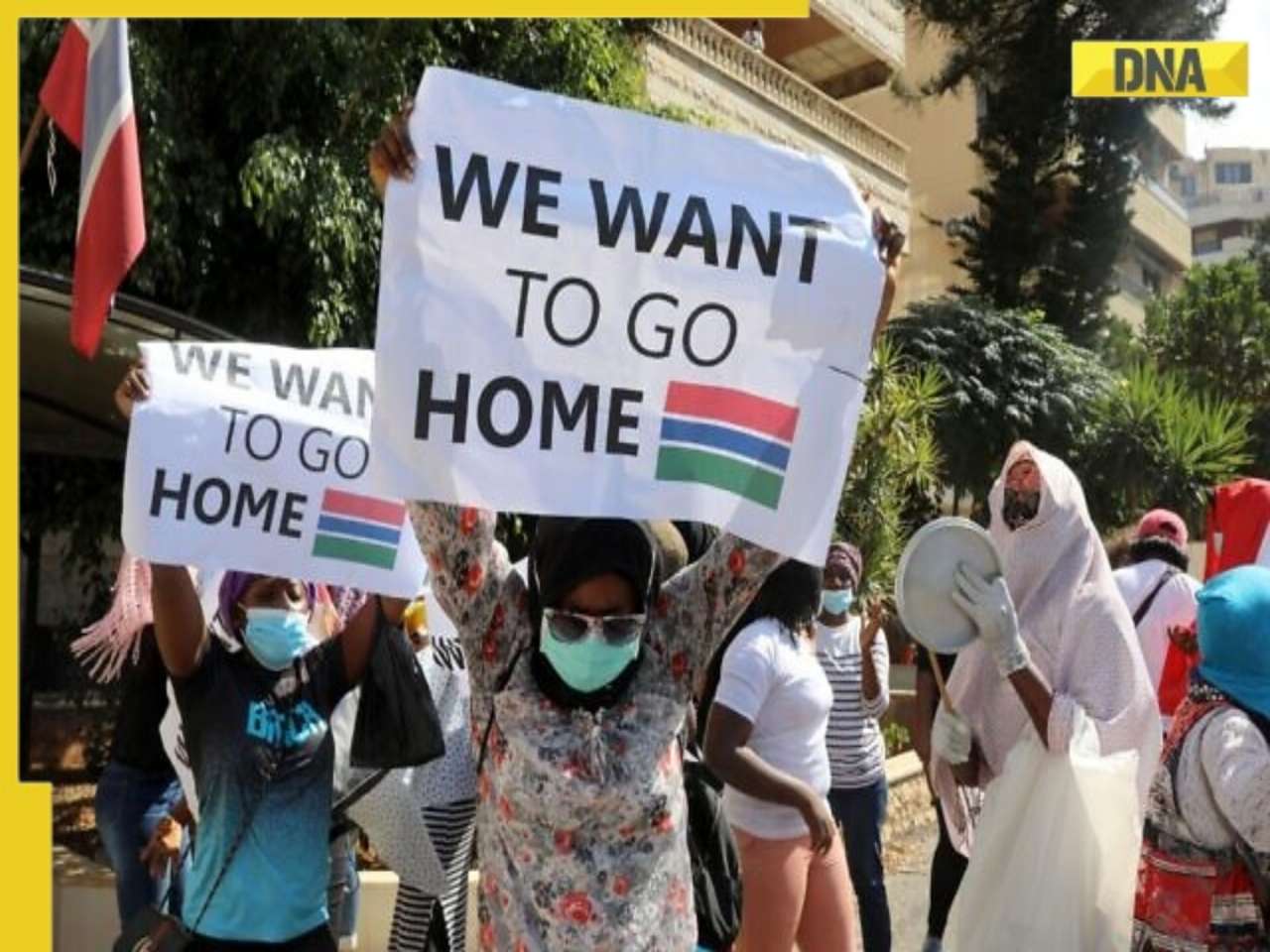More than 5,000 people have reportedly died in Turkey and Syria as a result of a magnitude 7.8 earthquake on Monday, and thousands more were injured because of the disaster.
Western Asian countries like Turkey, Syria, and Lebanon suffered devastation on February 6 as a deadly 7.8-magnitude earthquake rattled the area in the early hours of Monday. In addition to aftershocks, the enormous earthquake was followed by a 7.5-magnitude earthquake about nine hours later.
The reports state that the earthquake was so strong that Cyprus, Lebanon, Israel, and Egypt all experienced tremors. This deadly disaster has claimed the lives of up to 5000 people and injured thousands more. In 10 southern provinces, Turkish President Recep Erdogan officially declared a three-month state of emergency.
Syria's ambassador to India, Bassam Alkhatib, described the situation following the earthquake as "dangerous," noting that thousands of casualties had also been reported in the nation and that over 850 people had died. Syria has also been impacted by the Turkish earthquake with a Pazarcik district epicentre.
According to Turkish President Recep Tayyip Erdogan, 3,549 people have now died as a result of Turkey's earthquakes. According to the Ministry of Health and the rescue group White Helmets, at least 1,602 people have died and about 3,500 have been injured in Syria.
READ | Turkey-Syria Earthquake live updates: Turkish President Recep Erdogan declares 3-month state of emergency
Key points you must know about Turkey-Syria earthquake
According to the U.S. Geological Survey, the earthquake had a depth of 11 miles (18 kilometres) and was centred in southern Turkey, close to Syria's northern border. Since the initial earthquake, the two nations have experienced numerous aftershocks.
According to USGS research geologist Alex Hatem, the area had experienced 13 significant aftershocks with a magnitude of at least 5 in the first 11 hours. Nine hours after the initial jolt, Turkey was hit by a second powerful earthquake with a magnitude of 7.5. Scientists concurred that the two quakes are related even though they were examining whether that was an aftershock.
Turkey is located in an area of seismic activity. It's situated on the Anatolia tectonic plate, which is sandwiched between the Eurasian and African plates. The minor Arabian plate further limits movement on the north side. The North Anatolian fault (NAF) line, which connects the tectonic plates of Anatolia and Eurasia, is one fault line that is regarded as "particularly devastating." According to Scientific American magazine, the most recent earthquake charged a fault rupture that was relatively shallow (18 km below the earth's surface), intensifying surface motions.
Following the earthquake, thousands of buildings reportedly collapsed, according to officials. They included "pancake" collapses, in which the top floors of a building fall directly onto the lower floors, indicating that the structures were unable to withstand the shaking, according to USGS structural engineer Kishor Jaiswal. Freezing weather and traffic jams caused by people trying to leave earthquake-affected areas have hindered rescue efforts.
Local authorities reported that 10 more people died in Sanliurfa, which is close to Turkey's border with Syria, while five people died in the province of Osmaniye. In the province of Malatya, at least 130 buildings collapsed, and authorities found three bodies. Officials in the area reported that about 100 people had been taken to hospitals. Pro-government media in Syria reported that numerous buildings had partially wrecked in Hama. On Syria's west coast, close to Latakia, a building was reported to have also collapsed by state television.
READ | Earthquake to strike India soon? Here's what Dutch Researcher, who predicted Turkey-Syria earthquake, says
Another significant earthquake of magnitude 6.7 that significantly damaged the eastern part of Turkey struck Turkey in January 2020. Approximately 18,000 people were killed in 1999 when a 7.4 magnitude earthquake struck close to Istanbul.
A meeting was held, and it was decided that the NDRF's search and rescue teams, medical teams, and relief supplies would be sent out right away in cooperation with the Turkish government, according to a statement issued by the Indian Prime Minister's Office (PMO) on Monday.
On Tuesday, two National Disaster Response Force (NDRF) teams totaling 101 individuals departed for Turkiye. Aside from two search dogs, four-wheeled vehicles, chipping hammers, cutting tools, first aid supplies, and communication equipment, the federal contingency force is also equipped with these items. Two Indian Air Force (IAF) C-17 aircraft took off from the Hindon air base in Ghaziabad carrying the personnel, who were members of teams with bases in Ghaziabad and Kolkata.
As the extent of the disaster becomes more apparent, the rest of the world has moved quickly to offer aid to Turkey and Syria. Tuesday morning saw the arrival of aircraft carrying food, medicine, and blankets from Iran and Iraq at Damascus International Airport in Syria. In response to Japan's announcement, the first of two disaster relief teams with dog squads and medical supplies departed India for Turkey on Monday night. In addition, Pakistan has sent two search and rescue teams to the devastated nation, and Australia and New Zealand have pledged financial support for relief efforts.
While the United States declared it would send two relief and recovery units to Turkey, the European Union activated its crisis response system. In order to aid in rescue efforts, Palestinian civil defence and medical teams will also be sent to Turkey and Syria. Emergency response teams from the WHO's Emergency Medical Teams (EMT), the International Search and Rescue Advisory Group (INSARAG), and the United Nations Office for the Coordination of Humanitarian Affairs (UNOCHA) have been mobilised to Turkey to help with the relief efforts, according to UNOCHA.
READ | Earthquake risk: With 4 seismic zones in India, know which parts are in top zone
(With inputs from agencies)
![submenu-img]() DNA TV Show: Why Opposition is contesting Lok Sabha Speaker election
DNA TV Show: Why Opposition is contesting Lok Sabha Speaker election![submenu-img]() When Reena Roy broke her silence on her uncanny resemblance with rumoured ex Shatrughan Sinha's daughter Sonakshi Sinha
When Reena Roy broke her silence on her uncanny resemblance with rumoured ex Shatrughan Sinha's daughter Sonakshi Sinha![submenu-img]() Kangana Ranaut announces new release date of Emergency with new poster, fans say 'fifth National Award loading'
Kangana Ranaut announces new release date of Emergency with new poster, fans say 'fifth National Award loading'![submenu-img]() Makeover of homeless woman leaves internet stunned, netizens says...
Makeover of homeless woman leaves internet stunned, netizens says...![submenu-img]() Beginner SARM Cycle Guide: Best SARMs Stack For Beginners (Bulking, Cutting, Strength)
Beginner SARM Cycle Guide: Best SARMs Stack For Beginners (Bulking, Cutting, Strength)![submenu-img]() Meet Indian genius who saved lakhs of lives with his discovery, received six Nobel nominations, but never won due to…
Meet Indian genius who saved lakhs of lives with his discovery, received six Nobel nominations, but never won due to…![submenu-img]() What is 'space hairdryer' technique which can save million lives amid rise in heart attack cases?
What is 'space hairdryer' technique which can save million lives amid rise in heart attack cases?![submenu-img]() India's most educated man earned 20 degrees, cracked UPSC twice, later resigned as IAS officer due to…
India's most educated man earned 20 degrees, cracked UPSC twice, later resigned as IAS officer due to…![submenu-img]() NEET PG 2024: NBE President Abhijat Sheth makes big announcement, reveals exam date will be declared on..
NEET PG 2024: NBE President Abhijat Sheth makes big announcement, reveals exam date will be declared on..![submenu-img]() Meet engineer who quit job to crack UPSC, took up a part-time job to pay coaching fees, failed prelims 5 times then...
Meet engineer who quit job to crack UPSC, took up a part-time job to pay coaching fees, failed prelims 5 times then...![submenu-img]() DNA Verified: Did Kangana Ranaut party with gangster Abu Salem? Actress reveals who's with her in viral photo
DNA Verified: Did Kangana Ranaut party with gangster Abu Salem? Actress reveals who's with her in viral photo![submenu-img]() DNA Verified: New Delhi Railway Station to be closed for 4 years? Know the truth here
DNA Verified: New Delhi Railway Station to be closed for 4 years? Know the truth here![submenu-img]() DNA Verified: Did RSS chief Mohan Bhagwat praise Congress during Lok Sabha Elections 2024? Know the truth here
DNA Verified: Did RSS chief Mohan Bhagwat praise Congress during Lok Sabha Elections 2024? Know the truth here![submenu-img]() DNA Verified: Is CAA an anti-Muslim law? Centre terms news report as 'misleading'
DNA Verified: Is CAA an anti-Muslim law? Centre terms news report as 'misleading'![submenu-img]() DNA Verified: Lok Sabha Elections 2024 to be held on April 19? Know truth behind viral message
DNA Verified: Lok Sabha Elections 2024 to be held on April 19? Know truth behind viral message![submenu-img]() Alia Bhatt mesmerises in gown, Ranbir Kapoor looks classy in tuxedo in latest romantic photos, fans say 'couple goals'
Alia Bhatt mesmerises in gown, Ranbir Kapoor looks classy in tuxedo in latest romantic photos, fans say 'couple goals'![submenu-img]() Newlyweds Sonakshi Sinha-Zaheer Iqbal pose candidly with paps; Anil Kapoor, Kajol, Huma Qureshi attend wedding reception
Newlyweds Sonakshi Sinha-Zaheer Iqbal pose candidly with paps; Anil Kapoor, Kajol, Huma Qureshi attend wedding reception![submenu-img]() Meet Lovekesh Kataria: Elvish Yadav's close friend, Bigg Boss OTT 3 contestant who lied to father, spent his fees on...
Meet Lovekesh Kataria: Elvish Yadav's close friend, Bigg Boss OTT 3 contestant who lied to father, spent his fees on...![submenu-img]() From Highway to Chandu Champion: 5 underrated gems from Sajid Nadiadwala
From Highway to Chandu Champion: 5 underrated gems from Sajid Nadiadwala![submenu-img]() In pics: Bigg Boss OTT 3 house with dragons, two-sided walls is all about fantasy coming alive
In pics: Bigg Boss OTT 3 house with dragons, two-sided walls is all about fantasy coming alive![submenu-img]() Explained: Why is Kerala demanding to change its name to Keralam?
Explained: Why is Kerala demanding to change its name to Keralam?![submenu-img]() DNA Explainer: What is Kafala system that is prevalent in gulf countries? Why is it considered extremely brutal?
DNA Explainer: What is Kafala system that is prevalent in gulf countries? Why is it considered extremely brutal? ![submenu-img]() Lok Sabha Elections 2024: What are exit polls? When and how are they conducted?
Lok Sabha Elections 2024: What are exit polls? When and how are they conducted?![submenu-img]() DNA Explainer: Why was Iranian president Ebrahim Raisi seen as possible successor to Ayatollah Khamenei?
DNA Explainer: Why was Iranian president Ebrahim Raisi seen as possible successor to Ayatollah Khamenei?![submenu-img]() DNA Explainer: Why did deceased Iranian President Ebrahim Raisi wear black turban?
DNA Explainer: Why did deceased Iranian President Ebrahim Raisi wear black turban?![submenu-img]() When Reena Roy broke her silence on her uncanny resemblance with rumoured ex Shatrughan Sinha's daughter Sonakshi Sinha
When Reena Roy broke her silence on her uncanny resemblance with rumoured ex Shatrughan Sinha's daughter Sonakshi Sinha![submenu-img]() Kangana Ranaut announces new release date of Emergency with new poster, fans say 'fifth National Award loading'
Kangana Ranaut announces new release date of Emergency with new poster, fans say 'fifth National Award loading'![submenu-img]() Indian 2 trailer: Kamal Haasan's Senapathy leads second war of independence, fans say 'Rs 1000 crore confirmed'
Indian 2 trailer: Kamal Haasan's Senapathy leads second war of independence, fans say 'Rs 1000 crore confirmed'![submenu-img]() Watch: Jaideep Ahlawat loses more than 26 kgs in 5 months for Maharaj, his amazing physical tranformation stuns fans
Watch: Jaideep Ahlawat loses more than 26 kgs in 5 months for Maharaj, his amazing physical tranformation stuns fans![submenu-img]() Meet Rachit Singh, Huma Qureshi's rumoured boyfriend, has worked with Anushka, Alia, Ranveer, was last seen in...
Meet Rachit Singh, Huma Qureshi's rumoured boyfriend, has worked with Anushka, Alia, Ranveer, was last seen in...![submenu-img]() Makeover of homeless woman leaves internet stunned, netizens says...
Makeover of homeless woman leaves internet stunned, netizens says...![submenu-img]() Mango for Rs 2400, Ladyfinger for Rs 650: Common Indian food items are selling for whopping price in.....
Mango for Rs 2400, Ladyfinger for Rs 650: Common Indian food items are selling for whopping price in.....![submenu-img]() Meet British-Indian who drove 18300 km from London to Maharashtra to meet..
Meet British-Indian who drove 18300 km from London to Maharashtra to meet..![submenu-img]() Elon Musk confirms birth of his 12th child, welcomed baby with Neuralink executive earlier this year
Elon Musk confirms birth of his 12th child, welcomed baby with Neuralink executive earlier this year![submenu-img]() Isha Ambani did something which Shloka Mehta, Radhika Merchant are yet to do, she used 6-year-old...
Isha Ambani did something which Shloka Mehta, Radhika Merchant are yet to do, she used 6-year-old...






































)


















)
)
)
)
)
)